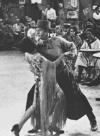- tango
-
/tang"goh/, n., pl. tangos, v., tangoed, tangoing.n.1. a ballroom dance of Latin-American origin, danced by couples, and having many varied steps, figures, and poses.2. music for this dance.3. a word used in communications to represent the letter T.v.i.4. to dance the tango.[1910-15; < AmerSp < ?]
* * *
It evolved into a ballroom dance in Buenos Aires, Arg., possibly influenced by the Cuban habanera. It was made popular in the U.S. by Vernon and Irene Castle, and by 1915 it was being danced throughout Europe. Early versions were fast and exuberant; these were later modified to the smoother ballroom step, characterized by long pauses and stylized body positions and danced to music in 44 time. Tango danced by Rudolph Valentino and partner from the motion picture Four Horsemen of the ...By courtesy of Metro-Goldwyn-Mayer Inc., © 1921; photograph, from the Museum of Modern Art Film Stills Archive
Tango danced by Rudolph Valentino and partner from the motion picture Four Horsemen of the ...By courtesy of Metro-Goldwyn-Mayer Inc., © 1921; photograph, from the Museum of Modern Art Film Stills Archive* * *
▪ danceballroom dance, musical style, and song. The tango evolved about 1880 in dance halls and perhaps brothels in the lower-class districts of Buenos Aires, where the Spanish tango, a light-spirited variety of flamenco, merged with the milonga, a fast, sensual, and disreputable Argentine dance; it also shows possible influences from the Cuban habanera. In the early 1900s the tango became socially acceptable and by 1915 was a craze in fashionable European circles. The first tango music by known composers was published in 1910.The early tangos were spirited and lively, but by 1920 the music and lyrics had become intensely melancholy. The tango step likewise evolved from early exuberance to a smoother ballroom step, and the prevailing duple metre (2/4) into 4/4, 4/8, or other tempo.The list of names of those most strongly associated with tango is long, but among the best-known are Juan d'Arienzo, Anibal Troilo, Osvaldo Pugliese, Carlos Di Sarli, Francisco Canaro, Astor Piazzolla (Piazzolla, Astor), and Carlos Gardel.* * *
Universalium. 2010.
